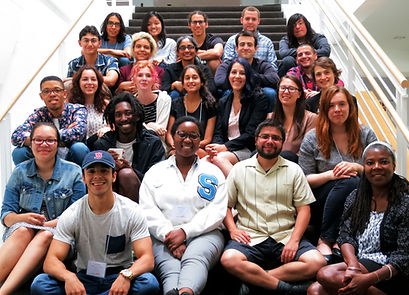Natalie Hobson
Research with Undergraduates

-
MSRI-UP (Undergraduate Program) REU on Sandpile Groups
-
Berkeley, CA, June 11th- 24th, 2016
-
Graduate assistant working with research director Luis Garcia-Puente and program director Suzanne L. Weekes.
-
The mission of this program is to encourage students from underrepresented communities to pursue mathematics related degrees and provide them a summer mathematics research experience.
-
At this program, I worked with 18 undergraduate students, taking a lead role in designing Sage (programing) tutorials and being the lead advisor to two groups of three students.
-
Student Projects:
On the Sandpile Group of Circulant Graphs
Students: Anna Comito, Jennifer Garcia, Justin Rivera
Circulant graphs are of interest in many areas of mathematics, particularly geometric group theory, because of the beautiful cyclic symmetries they display. These graphs have adjacency matrices that are circulant and can be defined from a set of integer generators A={a_1, …, a_m}, on a fixed number of n vertices, denoted C_n(A). Given any graph, one can construct a matrix, called the Laplacian matrix, from the data of the degree and adjacencies of each vertex. The cokernel of this matrix determines the sandpile group of the graph. The order of the sandpile group is always equal to the number of spanning trees of the graph. In this sense, the sandpile group is a more subtle invariant. It has been shown that the number of spanning trees of circulant graphs with a given set of generators follows a recursive formula. One can then ask if this structure is reflected in the corresponding sandpile groups as well. Previous results on the sandpile group for C_n(1,2) seem to infer this may be the case.
In this project, we create a database of isomorphism classes and sandpile groups for a large collection of circulant graphs. From our database, we are able to conclude that such nice structure is not always preserved in the sandpile group and hence the sandpile group is a more elusive graph invariant. We further focus our attention to the case C_n(1,3) in order to determine the explicit structure of the sandpile group for this family of graphs.
Combinatorial and Algebraic Properties of Generalized Crown Graphs
Students: Carlos Angrinsoni-Santiago, Angel Burr, Ruben Hurtado
In this project we study the combinatorial and algebraic properties of the generalized crown graphs. Such a graph is a regular bipartite graph defined by two parameters, n the number of vertices in each disjoint set and r the degree of each vertex. We have observed that this family of graphs includes many previously well-studied graphs such as complete bipartite graphs, prism graphs, and Möbius ladder graphs.
In our work, we construct an explicit isomorphism to show that a generalized crown graph is a circulant graph when r is even or the parity of r and n are equal. Circulant graphs are well studied and our isomorphism provides a portal to understanding such cases. We show, however, that generalized crown graphs in the other cases are indeed not circulant yet they seem to display many nice combinatorial properties similar to circulant graphs. Particularly, the number of spanning trees of a circulant graph follows explicitly defined recursive formulas. Our investigations show this appears to be the case for all generalized crown graphs as well. We study in depth the first unexplored generalized crown graph of this type, for r=5 and n even, in order to make conclusions about combinatorial and algebraic properties.


Fordham REU, June 2014
From left to right: Dr. David Swinarski, Natalie Hobson, Katherine Lee, Amanda Lu, and Ruiju Wang.
-
Fusion coefficients for type C_2 conformal blocks REU,
-
Mathematics Department at Fordham University, New York, NY, May-June 2014.
-
Research Assistant. Morning lecture on Lie algebras and afternoon problem sessions.
-
Director: David Swinarski
-